- Home
- Jimmy Guieu
Polarian-Denebian War 1: The Time Spiral Page 2
Polarian-Denebian War 1: The Time Spiral Read online
Page 2
It was necessary to look straight at him to see him. Looking a little to the right or left he disappeared into a hazy, vaporous shape. Only his blue eyes were clearly visible because the transparent serum had no effect on them. The faint cloudiness of his inner organs could barely be seen.
“So, Dr. Kariven, what do you say?” Streiler laughed at his flabbergasted stare. “This GI who accepted the experiment enthusiastically got the shots of transparency as well as those that protect his visual organs. The operation is absolutely painless and safe. The effect of this serum, depending on the dose, varies between one, five and ten hours. Prolonging it beyond ten hours presents certain drawbacks that we still haven’t been able to eliminate.”
“But how… how is this possible?”
“You’ve no doubt heard of Dr. Vasiliev?”
“Of course. The physiologist who ran around Russia during that last war in an exhibit car with a horse made somewhat transparent and two or three human corpses you could see through to the ravages of alcoholism5.”
“Exactly. Our biologists took up the Russian scientist’s work and created a serum that makes all the tissues of the human body transparent. The effect of one shot takes 30 or 40 minutes to manifest and depending on the dose it lasts between one and ten hours. The serum gives the body such a weak refraction index that you’d really have to know that a transparent man is in such or such a place to see him in full daylight. At night, in the shadows, he’s practically invisible. Of course he has to be naked, or almost, to become transparent because even though we can treat the body effectively, the same can’t be said for clothes. If you’re wearing pants, shirt, shoes and a hat you’d look like a carnival freak and everybody would stare at you.”
Streiler gave the human “guinea pig” a friendly pat on the shoulder and told him, “A little more patience, Bob. In one and half hours you’ll be back to normal and you can go on leave. For a harmless experiment that lasts five hours you’ll get 15 days leave. Gotta admit that it’s worth playing the guinea pig!”
The man lit a Lucky Strike and laughed softly. Then he went back into the room where he lay down on a bunk and started thumbing through a magazine. The smoke that he blew out was enough to sometimes mask his entire body.
“Now we’re not talking theory anymore but practical application,” Streiler declared. “Departure in two hours. I have to check the insides of the ship and the set-up, the food reserves and the nuclear fuel before… lifting anchor,” he ended with a laugh.
The sliding doors of the giant hangar opened as the Willys Overland Jeep that Kariven, Harrington and Streiler had taken went to park in a corner of the vast building. The three scientists talked for a minute with the few official personnel who had come to watch this memorable event that was carefully kept secret.
The Retro-Timeship, a kind of metal cigar, 75 yards long by 25 in its widest diameter, stood in the middle of the hangar. Metalo-plastex portholes ran along its armored hull that could withstand the highest temperatures. A long radar pole stuck out from its “nose” in the middle of the cockpit, also in clear metalo-plastex.
A line of remote-controlled carts was transporting the crates of supplies and material that automatic lifters raised into the holds where uniformed men duly piled them up.
On the side of the machine was an oval hatchway where a man in a US Army uniform stood. On the lapel of his officer’s jacket was pinned the sign for Special Services: two gold arrows crossed. Over his left breast pocket the blue Wings on a shield under a five-pointed star designating his rank of Command Pilot. This officer of the Air Transport Command, Commander Mark Taylor, along with his team, was going to participate in the expedition into the Time Spiral.
The venture was under the aegis of the American government. There was no way for a private company to build such a ship or pay the enormous amounts for years of research to develop it. A group of financial backers would probably not be interested in “traveling into the past” but the government saw the problem in a different light. It was not without good reason nor without specific expectations that it had subsidized the research at the Nevada Center for this incredible project carried out in absolute secrecy. The future and the peace of the world might depend on it someday.
Commander Taylor gave a friendly salute to the newcomers. “Everything’s ready, Dr. Streiler. My men have brought in the bags of Professor Harrington and Dr. Kariven. Yours have been here since this morning. The crew is at their posts.”
“OK, Mark! Let’s climb on board,” Streiler announced as he stepped onto the telescopic stairs leading up to the hatchway.
Kariven walked around with a fascinated look in his eyes. He was in a metal corridor on the lower deck. Huge rivets held the plates of the double-layered inner hull. A luminescent tube ran along the ceiling sprinkling the corridor with bright light.
They followed Commander Taylor to the cockpit, which also served as the observation post. In front of the dome lit up by electroluminescence with a soft, blue light, the control panel console glimmered from all its dials and luminous buttons. To the right of the pilot’s chair had been added another control panel, smaller but complex enough to activate the “time retrograde” device: a kind of temporal accelerator.
Two seats for the observers were lined up on either side of the pilot. Streiler sat to the left of the commander while Harrington and Kariven took their places to the right.
Standing in front of the control panel, Commander Taylor made a sign with his hand to the mechanics on the ground. A powerful tractor came slowly out of the ship, which rolled on its four-train, detachable landing gear until it was 100 yards from the hangar. The tractor stopped. Its driver jumped to the ground and waved his arms over his head.
All the technicians, researchers and the “officials”—namely two high-ranking officers from the Pentagon—gathered in front of the hangar and watched with some nervousness as the giant cigar prepared for its flight.
The Commander answered the signal and activated a breaker with his right hand while his left worked the control of the anti-gravitational repeller. A faint rumbling filled the room and the metallic monster rose up slowly, leaving the tow-train on the ground.
Everyone gradually tensed up for the take off. The Retro-Timeship sped up its vertical ascent… then it disappeared from sight, vanishing like a puff of smoke being blown away by the wind.
“We’ve entered the Time Spiral!” Streiler announced, so full of emotion that his voice was flat.
Indeed, Commander Taylor had just activated the retrograde system and was carefully watching a big, light blue screen on his console where three needles were quivering over different colored and calibrated triangles. The officer turned on the automatic pilot and waited…
Suddenly a red light blinked on the top of the screen. The needles came to a stop, one over another. Right away a weird, dusky light filtered through the cockpit and the portholes of the extraordinary vehicle.
Kariven, Streiler and Harrington struggled in vain to see something through the portholes. Only this gloomy gray hue was visible.
“What’s happening?” Kariven asked.
“We’re traveling through the Time Spiral,” Harrington answered, turning on a visual periscope screen. The lighted rectangle showed an oscillating ball of indistinct color floating in the perpetual gray abstraction.
“This special visual process, which captures colored views in relief every millionth of a second, lets us see what our eyes can’t make out because the space/time movement of the Retro-Timeship is too fast. Thus, the hazy images on the screen right now are already in the past with respect to our present position, even though they’re taken at a millionth of a second. By the time they hit our retina their source is buried in the past that we’re leaving ‘behind us’.”
“So what does this strangely colored, oscillating sphere represent?”
“That’s Earth! Or rather the ghost of Earth, meaning what it was at some point in the past. The grayish, dusky glow s
urrounding us comes partly from the rapid succession of days and nights on the one hand and partly from passing through a dark and light hemisphere.”
In a split second the screen showed a series of very bright but brief flashes, then three blinding flashes in quick succession that attracted the attention of the observers.
Responding to Kariven’s unspoken question, Streiler gave the answer to the enigma. “What we’ve just glimpsed are the flashes from the nuclear experiments performed since 1945. We’re seeing them in reverse. The latest ones, in Montebello, Nevada, Eniwetok and Bikini, we’re the first ones we saw. The three other explosions that came afterward were the older ones from Hiroshima, Nagasaki and Los Alamos. We saw them in reverse chronological order; the last became the first.”
“We’re already in 1945?” Kariven expressed his surprise almost naïvely.
“You mean we were. The speed of the Retro-Timeship is constantly increasing since it is based on an acceleration. We’re diving deeper into the past every second.”
Streiler looked at a control panel and focused the screen onto starry space, at least such as was visible in a period of the past. The others followed his eyes and quickly saw an interesting phenomenon.
Like a ball of lightning, impossibly bright, a sphere exploded in space and vanished as quickly as it had appeared, leaving the screen open onto the abyss of the past.
“Right now we’re in the Middle Ages and what we just saw was none other than the Nova discovered by Tycho Brahe, the famous Danish astronomer, in 1572 in the constellation Cassiopeia… We can see these extraordinary phenomena again on our way back because there are cameras on all sides of the Retro-Timeship. They work automatically and are recording our whole expedition that we only catch a few, random glimpses of.”
“I’m getting used to not being surprised at anything,” Kariven said, “but I have to admit that this voyage is far beyond anything I’ve ever seen or lived through before. Where exactly are we going?”
“You should say… when are we going?” Streiler joked. “We’re going past the so-called prehistoric ages. The historic period stretches back from the 20th century to the first Egyptian dynasties and farther even into the Paleolithic, which doesn’t interest us for the moment. When our mutual friend, Professor Harrington, informed me that he wanted to bring you on this voyage into the past, he told me what you work on. I knew nothing about your remarkable work and your bold anthropological theories. You’ve come up with some stunning hypotheses about the origin of humanity. That persuaded me to bring you with us because this exploration of the Time Spiral will either confirm or deny your theories and it won’t be the least or last service the Retro-Timeship renders to Science.”
Commander Taylor turned away from his control panel and said, “We’re in the 45th millionth year before the atomic age. Should I stop?”
“45 million years before the atomic age!” Kariven exclaimed. “But that’s almost the beginning of the Tertiary period!”
“Exactly right,” Streiler confirmed with a smile. “We’ll stop here before going any farther back into the past. In your opinion, Kariven, what should we find on Earth in this epoch?”
“The geology shows that the continents were different and the fauna was monstrous.”
“And men?” Harrington asked.
“Science doesn’t give them such an ancient origin. Legend, however, says differently and upholds that 40 or 50 million years ago the Earth and its main continent, Lemuria, was inhabited.”
“OK, Mark!” Streiler rubbed his hands together. “You can stop at this time. Turn off the magneto-cosmotron generator. Everyone grab your suits and get ready to leave the Retro-Timeship.”
CHAPTER II
When Commander Taylor stopped the magneto-cosmotron that powered the Retro-Timeship along the Time Spiral, the gray dusk changed to night.
The stars in space showed up perfectly clear not only on the screen but through the portholes as well. The hazy, vibrating sphere lost its blurriness and looked like our planet, as it was 45 million years ago.
The planetary ghost transformed into a tangible world: the Earth of the past materialized at the point in space that it occupied at the start of the Tertiary period. Seeing the globe whose continents were completely different, the Time explorers felt something indefinable. They had the impression of flying over a totally unknown world at a very high altitude.
Nothing in this strange geography led them to believe that they were looking at the planet Earth. The two American continents did not yet exist. The South, a long, irregular mass, was “biting” what would later become Tierra del Fuego. Instead of present day Australia and Micronesia a huge continent took up a good part of the Pacific.
“Lemuria!” Kariven uttered. “What wouldn’t a geologist sacrifice to see such a sight! Look, right by the jagged sides of what will become Europe and Africa, there’s that huge island… That’s Atlantis or rather the island mountain that will give birth to it in the future… I mean in the past… Anyway, after this current Tertiary and before the Quaternary period in which we live in the atomic age,” the young French scientist stammered.
“Before landing, let’s fly over Lemuria and take a few pictures,” Professor Harrington proposed.
Commander Taylor reduced the strength of the anti-gravitational repeller and the ship lost altitude. The continental landmass of Lemuria seemed to shoot up, its coasts and terrain becoming clearer. Towards the interior a mountain range stretched from east to west.
The anti-gravitational counter showed the descent speed at 300 feet/second. The commander reduced it even more and watched the altimeter decreasing its reading: 30,000 feet… 25,000 feet… 20,000 feet… At 3,000 feet from the ground Commander Taylor abruptly stopped the descent and brought the ship to a standstill thanks to the lift reactors.
The occupants of the cockpit bellowed in surprise. Their faces glued to the portholes, stupefied, they stood speechless.
Before their eyes, in the gulf of a bay that gently lapped at the ocean, was a dazzling white city, an extraordinary city, with majestic palaces, towers, dwellings and a port with huge cranes and weird, thin ships without masts or funnels. To the northwest of the white city, a glimmering oval indicated the position of an aerodrome! Several machines of strange shapes—metal spheres mounted on tripods—were lined up in front of hemispherical hangars.
Fearing they might be spotted too soon, Commander Taylor activated the breaker of the device that absorbed—without sending them back—the electromagnetic waves capable of revealing them. Silent and motionless the Retro-Timeship would be very hard to spot now.
Kariven looked at his companions one by one and read the same surprise on their faces as was on his. He murmured, “Are you sure that we’re on Earth?”
“Absolutely. The Retro-Timeship never left the Time Spiral,” Commander Taylor confirmed.
“One of the metal spheres is taking off!” Kariven exclaimed.
Indeed, with a spray of pinkish flames, one of the spherical machines rose up slowly, sparkling in the bright sunlight, and retracting its tripod landing gear. The ship accelerated faster and faster and in a few seconds faded off into the horizon. Meanwhile three other spherical airships had taken off in three different directions.
“I hate to admit that 45 million years before the atomic age the earthlings had reached such a stage of development,” Kariven confessed dreamily.
“We would never admit it either,” Professor Harrington spread his hands out in resignation, “if we didn’t see this undeniable proof with our own eyes. A people living on the continent in the past as developed—if not more so—as us.”
“It fits with your theories, Dr. Kariven, on the origins of humanity,” Streiler said. “Despite all opposition you were right to believe that remarkable civilizations could have existed in the Tertiary period.”
“Yes, I said that, but still putting them at a more recent epoch, towards the end of the Tertiary or start of the Quaternary around 500,
000 years ago to one million maximum.”
“The impossibility of finding remains or traces of this civilization, as you maintained, Kariven,” Professor Harrington expounded, “is explained by the cataclysms that buried Lemuria and made Atlantis rise up. The cities and buildings, everything that the Lemurians had built was sunk to the bottom of the ocean, covered by hundreds of feet of sediment or even transformed through recrystallization into metamorphic rocks that we know very little about.”
Professor Harrington turned to Commander Taylor. “Let’s ascend into the atmosphere to stay out of sight and we can have a snack before visiting this ghostly white city of the past. We’ll give ourselves a dose of the transparency serum and when night falls we can operate in complete safety.”
The commander pressed the button for his interior video and called Rudy Clark, the specialist lieutenant assigned to the magneto-cosmotron, with his five-man team. His kindly face appeared on the screen.
“We’re climbing into the ionosphere, lieutenant. Get a meal ready that we can have when we reach maximum height. Over and out.”
“OK, Commander!” The Lieutenant saluted and the screen went dark.
The Retro-Timeship leaped into the sky, crossed the dense atmospheric layer in a blink of an eye and came to a halt at 60 miles altitude. At this height a purplish twilight replaced the daylight produced by the sun’s rays illuminating air molecules.
The four men left the cockpit and went down to the lower deck. In the mess room with riveted walls, Lieutenant Clark and his men were waiting for them, at attention, in front of a table that was already set.
All the occupants of the Time ship ate very democratically at the same table, served by one of the crew members. Commander Taylor chatted as freely with the three scientists as he did with his subordinates, Lieutenant Clark and the GI technicians assigned to the Special Service of the Air Material Command.

 Polarian-Denebian War 6: Prisoners of the Past
Polarian-Denebian War 6: Prisoners of the Past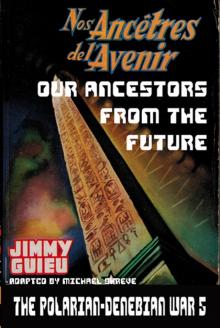 Polarian-Denebian War 5: Our Ancestors From the Future
Polarian-Denebian War 5: Our Ancestors From the Future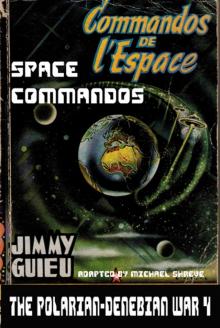 Polarian-Denebian War 4: Space Commandos
Polarian-Denebian War 4: Space Commandos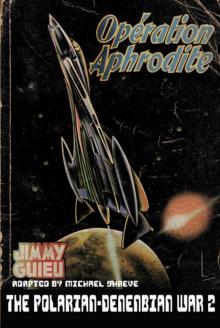 Polarian-Denebian War 2: Operation Aphrodite
Polarian-Denebian War 2: Operation Aphrodite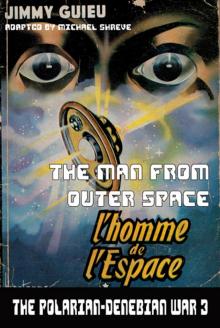 Polarian-Denebian War 3: The Man From Outer Space
Polarian-Denebian War 3: The Man From Outer Space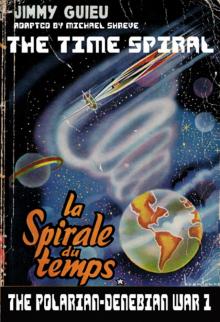 Polarian-Denebian War 1: The Time Spiral
Polarian-Denebian War 1: The Time Spiral